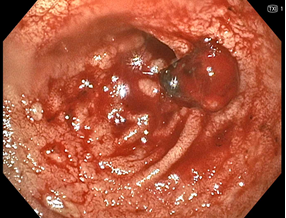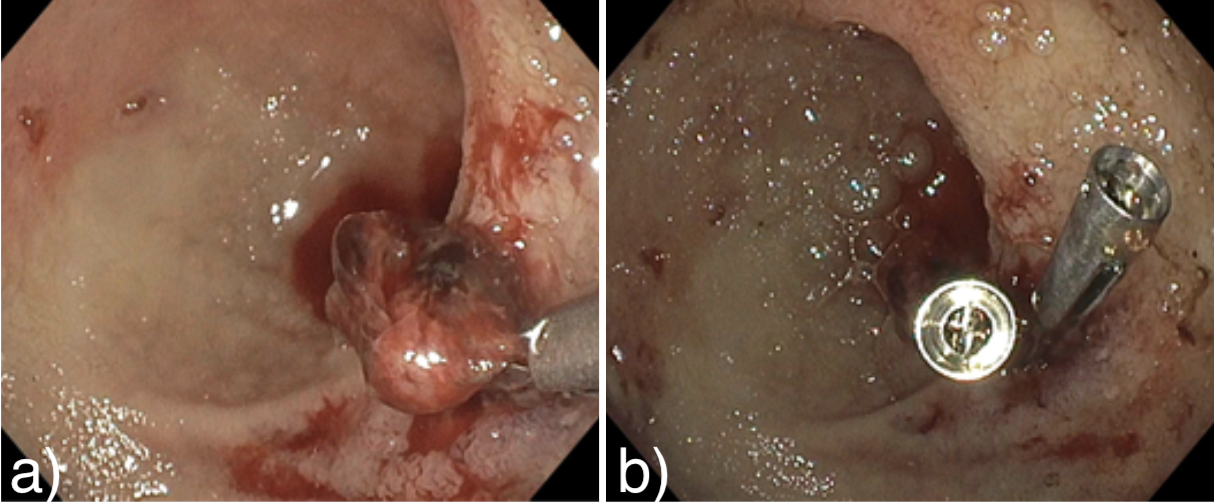Monday Poster Session
Category: GI Bleeding
P3138 - Shocked by a Bleeding Duodenal Polyp: A Case of Stress-Related Mucosal Disease
Monday, October 27, 2025
10:30 AM - 4:00 PM PDT
Location: Exhibit Hall

Yasasvhinie Santharam, DO (she/her/hers)
University of Florida College of Medicine
Jacksonville, FL
Presenting Author(s)
Yasasvhinie Santharam, DO, Sneh Parekh, DO, Claudia Aleman Oliva, DO, Luke Stachler, MD, Radhika Sharma, DO, Bruno Ribeiro, MD
University of Florida College of Medicine, Jacksonville, FL
Introduction: Duodenal polyps are a rare clinical finding, reported in 0.3-4.6% of patients referred for esophagogastroduodenoscopy (EGD). Most of these polyps are found to be adenomatous, and pedunculated polyps are more likely to cause bleeding than sessile polyps. Upper gastrointestinal bleeds (UGIB) can occur when vasopressors are used in the setting of septic shock, due to stress-related mucosal disease (SRMD). Vasopressors lead to mesenteric ischemia due to reduction of splanchnic blood flow which causes mucosal damage, ulceration, and bleeding from GI lesions.
Case Description/
Methods: An 85 year old male with a past medical history of asthma presented to the hospital with hypotension, tachycardia, and tachypnea. He was given 2L of intravenous fluids (IVF) and started on a norepinephrine and vasopressin. Pulmonary infiltrates were present on imaging, and increasing respiratory requirements led to intubation. The patient was admitted to the intensive care unit (ICU) for acute hypoxic respiratory failure in the setting of septic shock due to community acquired pneumonia. He completed a course of ceftriaxone and azithromycin, was weaned off pressors, extubated, and downgraded until his nurse noted melena. The patient was readmitted to the ICU for hemorrhagic shock in the setting of UGIB and was given 2U of packed red blood cells, IVF, IV pantoprazole, and sucralfate. A computed tomography scan of the abdomen showed no active contrast extravasation. The patient remained stable for several hours with an improvement in hemoglobin, then had a sudden episode of coffee-ground emesis requiring emergent intubation. An emergent EGD was performed, with a singular actively bleeding 6 mm sessile duodenal polyp in the posterior wall of the first portion of the duodenum (Fig. 1). Epinephrine was injected at the site and two hemostatic clips were placed with resolution of bleeding (Fig. 2).
Discussion: The incidence of duodenal polyps resulting in frank UGIB after the use of vasopressors is not well-documented in literature. We highlight the importance of including duodenal polyps in the differential for an UGIB, particularly in the setting of septic shock with vasopressor use, due to the bleeding risk associated with exacerbation of SRMD. This case demonstrates that duodenal polyps, specifically those with a visible and actively bleeding vessel, may be amenable to therapeutic options currently used in the setting of ulcerations with actively bleeding vessels.

Figure: Figure 1: The actively bleeding duodenal polyp as visualized on EGD

Figure: Figure 2: Cessation of bleeding observed from the visible vessel within the duodenal polyp after (a) the local injection of epinephrine and (b) application of two hemostatic clips
Disclosures:
Yasasvhinie Santharam indicated no relevant financial relationships.
Sneh Parekh indicated no relevant financial relationships.
Claudia Aleman Oliva indicated no relevant financial relationships.
Luke Stachler indicated no relevant financial relationships.
Radhika Sharma indicated no relevant financial relationships.
Bruno Ribeiro indicated no relevant financial relationships.
Yasasvhinie Santharam, DO, Sneh Parekh, DO, Claudia Aleman Oliva, DO, Luke Stachler, MD, Radhika Sharma, DO, Bruno Ribeiro, MD. P3138 - Shocked by a Bleeding Duodenal Polyp: A Case of Stress-Related Mucosal Disease, ACG 2025 Annual Scientific Meeting Abstracts. Phoenix, AZ: American College of Gastroenterology.
University of Florida College of Medicine, Jacksonville, FL
Introduction: Duodenal polyps are a rare clinical finding, reported in 0.3-4.6% of patients referred for esophagogastroduodenoscopy (EGD). Most of these polyps are found to be adenomatous, and pedunculated polyps are more likely to cause bleeding than sessile polyps. Upper gastrointestinal bleeds (UGIB) can occur when vasopressors are used in the setting of septic shock, due to stress-related mucosal disease (SRMD). Vasopressors lead to mesenteric ischemia due to reduction of splanchnic blood flow which causes mucosal damage, ulceration, and bleeding from GI lesions.
Case Description/
Methods: An 85 year old male with a past medical history of asthma presented to the hospital with hypotension, tachycardia, and tachypnea. He was given 2L of intravenous fluids (IVF) and started on a norepinephrine and vasopressin. Pulmonary infiltrates were present on imaging, and increasing respiratory requirements led to intubation. The patient was admitted to the intensive care unit (ICU) for acute hypoxic respiratory failure in the setting of septic shock due to community acquired pneumonia. He completed a course of ceftriaxone and azithromycin, was weaned off pressors, extubated, and downgraded until his nurse noted melena. The patient was readmitted to the ICU for hemorrhagic shock in the setting of UGIB and was given 2U of packed red blood cells, IVF, IV pantoprazole, and sucralfate. A computed tomography scan of the abdomen showed no active contrast extravasation. The patient remained stable for several hours with an improvement in hemoglobin, then had a sudden episode of coffee-ground emesis requiring emergent intubation. An emergent EGD was performed, with a singular actively bleeding 6 mm sessile duodenal polyp in the posterior wall of the first portion of the duodenum (Fig. 1). Epinephrine was injected at the site and two hemostatic clips were placed with resolution of bleeding (Fig. 2).
Discussion: The incidence of duodenal polyps resulting in frank UGIB after the use of vasopressors is not well-documented in literature. We highlight the importance of including duodenal polyps in the differential for an UGIB, particularly in the setting of septic shock with vasopressor use, due to the bleeding risk associated with exacerbation of SRMD. This case demonstrates that duodenal polyps, specifically those with a visible and actively bleeding vessel, may be amenable to therapeutic options currently used in the setting of ulcerations with actively bleeding vessels.

Figure: Figure 1: The actively bleeding duodenal polyp as visualized on EGD

Figure: Figure 2: Cessation of bleeding observed from the visible vessel within the duodenal polyp after (a) the local injection of epinephrine and (b) application of two hemostatic clips
Disclosures:
Yasasvhinie Santharam indicated no relevant financial relationships.
Sneh Parekh indicated no relevant financial relationships.
Claudia Aleman Oliva indicated no relevant financial relationships.
Luke Stachler indicated no relevant financial relationships.
Radhika Sharma indicated no relevant financial relationships.
Bruno Ribeiro indicated no relevant financial relationships.
Yasasvhinie Santharam, DO, Sneh Parekh, DO, Claudia Aleman Oliva, DO, Luke Stachler, MD, Radhika Sharma, DO, Bruno Ribeiro, MD. P3138 - Shocked by a Bleeding Duodenal Polyp: A Case of Stress-Related Mucosal Disease, ACG 2025 Annual Scientific Meeting Abstracts. Phoenix, AZ: American College of Gastroenterology.
